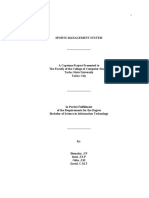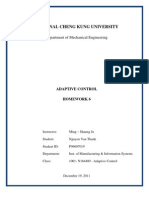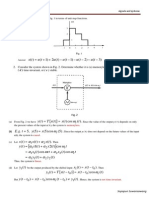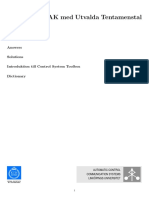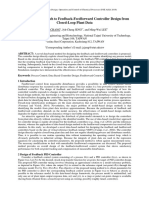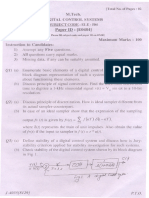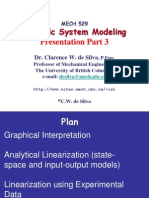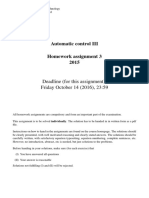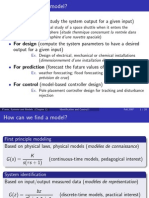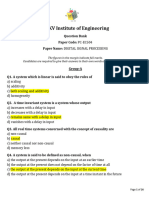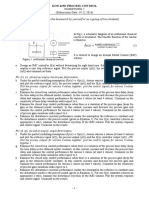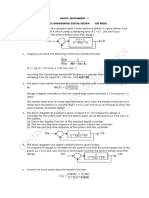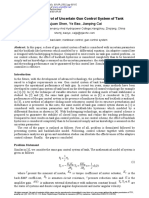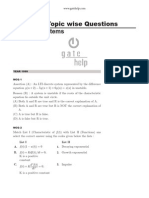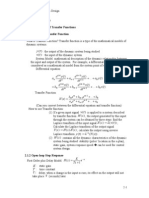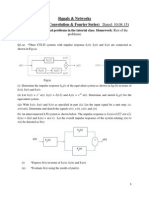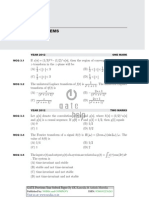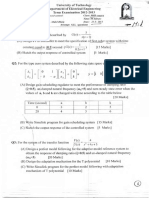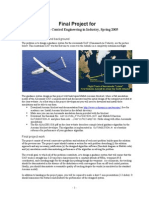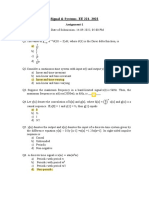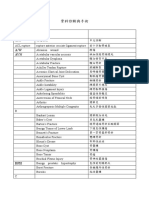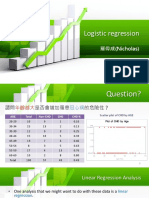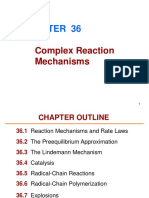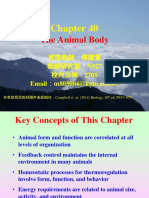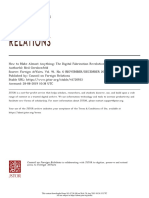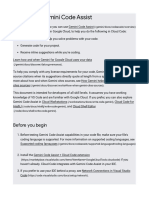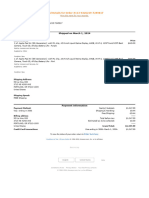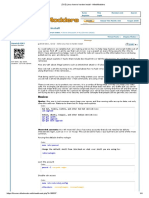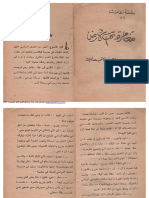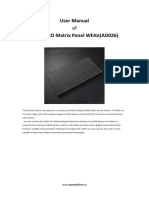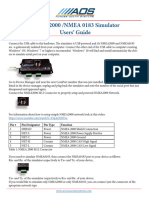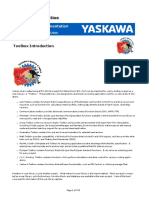0 ratings0% found this document useful (0 votes)
67 viewsYt Yt Ut Ut: Adaptive Control Homework 05 Pole-Placement Design and Indirect STR
Yt Yt Ut Ut: Adaptive Control Homework 05 Pole-Placement Design and Indirect STR
Uploaded by
law0516This document outlines 4 problems related to pole-placement design and indirect self-tuning regulation (STR) for an adaptive control homework assignment. The problems involve determining system polynomials, formulating a linear regression equation, simulating controllers with and without zero cancellation for different disturbances, and investigating how well an adaptive system can adapt to parameter variations with and without a forgetting factor. The goal is to examine the effects of disturbances and time delays on controller performance for different adaptive control designs.
Copyright:
© All Rights Reserved
Available Formats
Download as PDF, TXT or read online from Scribd
Yt Yt Ut Ut: Adaptive Control Homework 05 Pole-Placement Design and Indirect STR
Yt Yt Ut Ut: Adaptive Control Homework 05 Pole-Placement Design and Indirect STR
Uploaded by
law05160 ratings0% found this document useful (0 votes)
67 views2 pagesThis document outlines 4 problems related to pole-placement design and indirect self-tuning regulation (STR) for an adaptive control homework assignment. The problems involve determining system polynomials, formulating a linear regression equation, simulating controllers with and without zero cancellation for different disturbances, and investigating how well an adaptive system can adapt to parameter variations with and without a forgetting factor. The goal is to examine the effects of disturbances and time delays on controller performance for different adaptive control designs.
Original Title
Homework_05.pdf
Copyright
© © All Rights Reserved
Available Formats
PDF, TXT or read online from Scribd
Share this document
Did you find this document useful?
Is this content inappropriate?
This document outlines 4 problems related to pole-placement design and indirect self-tuning regulation (STR) for an adaptive control homework assignment. The problems involve determining system polynomials, formulating a linear regression equation, simulating controllers with and without zero cancellation for different disturbances, and investigating how well an adaptive system can adapt to parameter variations with and without a forgetting factor. The goal is to examine the effects of disturbances and time delays on controller performance for different adaptive control designs.
Copyright:
© All Rights Reserved
Available Formats
Download as PDF, TXT or read online from Scribd
Download as pdf or txt
0 ratings0% found this document useful (0 votes)
67 views2 pagesYt Yt Ut Ut: Adaptive Control Homework 05 Pole-Placement Design and Indirect STR
Yt Yt Ut Ut: Adaptive Control Homework 05 Pole-Placement Design and Indirect STR
Uploaded by
law0516This document outlines 4 problems related to pole-placement design and indirect self-tuning regulation (STR) for an adaptive control homework assignment. The problems involve determining system polynomials, formulating a linear regression equation, simulating controllers with and without zero cancellation for different disturbances, and investigating how well an adaptive system can adapt to parameter variations with and without a forgetting factor. The goal is to examine the effects of disturbances and time delays on controller performance for different adaptive control designs.
Copyright:
© All Rights Reserved
Available Formats
Download as PDF, TXT or read online from Scribd
Download as pdf or txt
You are on page 1of 2
Adaptive Control Homework 05 Pole-Placement Design and Indirect STR
Due date: 5/12/2016
P1. Consider the system y (t ) − 0.5 y (t −=
1) 0.6 u(t − 9) + 0.2 u(t − 10)
(a) Determine the polynomials A(q), B(q), A*(q), B*(q) in the representation
A( q) y (t ) = B( q) u(t )
and
( q −1 ) y ( t ) B * ( q − 1 ) u ( t − d 0 )
A*=
(b) Formulate the linear regression equation for RLS estimates of the model
parameters.
(c) How many sampling periods are required for convergence of the model
parameters?
P2. Consider a process
y (t ) =−a1 y (t − 1) − a2 y (t − 2) + b0u (t − 1) + b1u (t − 2)
− b0v (t − 1) − b1v (t − 2)
with parameters [a1, a2, b0, b1]=[ -1.4459, 0.6672, 0.1172, 0.08118 ].
Select a desired closed-loop system described by
y=
m (t ) am1 ym (t − 1) − am 2 ym (t − 2) + bm 0uc (t − 1)
where uc and ym are the command and the desired output respectively.
(a) Neglect the disturbance and design a controller in which the stable zero of process
model is canceled.
(b) Neglect the disturbance and design a controller in which no zero of process model
is canceled. Choose a proper delay d0.
(c) Simulate above designs for a square wave command of amplitude 1 and period of
50 sampling periods for disturbance free case. Plot y(t), uc(t), u(t) and estimates of
process model parameters vs. time t.
(d) Same as (c) except that at time t = 40 a step disturbance with amplitude of 0.1 is
applied.
(e) Compare the tracking performance, ringing of input of the two designs for (c) and
(d). What are effects of disturbance on the performance of the controllers?
P3. Consider a process
y (t ) =−a1 y (t − 1) − a2 y (t − 2) + b0u (t − 1) + b1u (t − 2)
− b0v (t − 1) − b1v (t − 2)
In which parameters { a1, a2, b0, b1 } are unknown constants.
Choose a proper desired closed-loop system
y=m (t ) am1 ym (t − 1) − am 2 ym (t − 2) + bm 0uc (t − 1)
where uc and ym are the command and the desired output respectively.
(a) Neglect the disturbance and design an indirect STR in which the stable zero of
process model is canceled.
(b) Neglect the disturbance and design an indirect STR in which no zero of process
model is canceled. Choose a proper delay d0.
(c) Simulate above designs using following process parameters
[a1, a2, b0, b1]=[-1.4459, 0.6672, 0.1172, 0.08118].
Choose proper initial guess of above parameters. The command is a square wave
of amplitude 1 and period of 50 sampling periods. At time t = 40 a step
disturbance with amplitude 0.1 is applied to the system. Plot y(t), uc(t), u(t) and
estimated parameters vs. t. Examine the effects of the disturbance on performance
of your controller. Compare the tracking performance, ringing of input and
disturbance rejection of the two designs. Discuss on the effect of time delay on the
performance of the adaptive controller.
P4. (a) Consider the indirect STR (without zero cancellation) in P2 and neglect the
disturbance. Modify your simulation program so that the parameters of the process are
reduced by 20% from their true values starting from time 40 and back to original
values at time 80. Investigate experimentally how well the adaptive system can adapt
to the parameter variations. (b) Introduce a proper forgetting factor (λ<1) and
compare the performance with that without forgetting factor (λ=1).
You might also like
- Company's Ability To Produce Chips That Meet Specifications? The Elements That TheDocument4 pagesCompany's Ability To Produce Chips That Meet Specifications? The Elements That TheMikey MadRatNo ratings yet
- Sports Management System Final Manuscript Group 4Document47 pagesSports Management System Final Manuscript Group 4Arlene Marie Carreon50% (4)
- The Complete Guide To Atlassian For ITSMDocument107 pagesThe Complete Guide To Atlassian For ITSMPRAHASITH G100% (3)
- Adaptive Control Theory: Direct Self-Tuning Regulators and Internal ModelDocument27 pagesAdaptive Control Theory: Direct Self-Tuning Regulators and Internal ModelThanh NguyenNo ratings yet
- Signals & Systems (Solved Problems)Document7 pagesSignals & Systems (Solved Problems)Lohith Coreel100% (1)
- RT Exercises and Solutions Med TentatalDocument264 pagesRT Exercises and Solutions Med TentatalSANA100% (1)
- Calculations Estimation Parameter: Block Diagram of A Self Tuning RegulatorDocument10 pagesCalculations Estimation Parameter: Block Diagram of A Self Tuning Regulatorvk2you009No ratings yet
- Digital Control System Paper PDFDocument2 pagesDigital Control System Paper PDFdeepaksaini14No ratings yet
- Data-Based Approach To Feedback-Feedforward Controller Design From Closed-Loop Plant DataDocument6 pagesData-Based Approach To Feedback-Feedforward Controller Design From Closed-Loop Plant DataArif HidayatNo ratings yet
- Proj2 ControlDocument5 pagesProj2 ControlBarak HenenNo ratings yet
- TSExamples PDFDocument9 pagesTSExamples PDFKhalilNo ratings yet
- Signals & SystemsDocument48 pagesSignals & Systemsailamrudhula100% (1)
- PEE-504 IDdcsE0484Document2 pagesPEE-504 IDdcsE0484Melissa CannonNo ratings yet
- Ele-504 Id-E0484Document2 pagesEle-504 Id-E0484suma sriNo ratings yet
- 436-405 Advanced Control Systems: Page 1 of 7Document6 pages436-405 Advanced Control Systems: Page 1 of 7aungwinnaingNo ratings yet
- Control Systems Theory and Design: ExaminationDocument5 pagesControl Systems Theory and Design: ExaminationLuis CarvalhoNo ratings yet
- Dynamic System ModelingDocument53 pagesDynamic System ModelingDaniel SonNo ratings yet
- Project Fall2015Document5 pagesProject Fall2015AlvinNo ratings yet
- Automatic Control III Homework Assignment 3 2015Document4 pagesAutomatic Control III Homework Assignment 3 2015salimNo ratings yet
- For Simulation (Study The System Output For A Given Input)Document28 pagesFor Simulation (Study The System Output For A Given Input)productforeverNo ratings yet
- ps3 (1) From MAE 4780Document5 pagesps3 (1) From MAE 4780fooz10No ratings yet
- Eee 550 - Advanced Control Systems November 2008Document7 pagesEee 550 - Advanced Control Systems November 2008Kumaraguru RauNo ratings yet
- Smith 1997Document5 pagesSmith 1997Lucas SantosNo ratings yet
- Vibration Matlab v9Document10 pagesVibration Matlab v9b_miniraoNo ratings yet
- MCKV Institute of EngineeringDocument26 pagesMCKV Institute of EngineeringRahul ProdhanNo ratings yet
- MATLAB ProblemsDocument4 pagesMATLAB ProblemsPriyanka TiwariNo ratings yet
- Lecture03(Math_Rep1)Document73 pagesLecture03(Math_Rep1)Getahun Shanko KefeniNo ratings yet
- CTRJun2010 (حديث)Document3 pagesCTRJun2010 (حديث)Eng M. EissaNo ratings yet
- DescriptionDocument2 pagesDescriptionHasan ÇalışkanNo ratings yet
- ELEC4632 - Lab - 01 - 2022 v1Document13 pagesELEC4632 - Lab - 01 - 2022 v1wwwwwhfzzNo ratings yet
- Review PPT Modified KLJLKDocument30 pagesReview PPT Modified KLJLKPranith KumarNo ratings yet
- EE301 Fall22 HW4 v4Document2 pagesEE301 Fall22 HW4 v46kberkaygulluNo ratings yet
- Control System 2014 Midterm Exam. 1 (2 Pages, 38 Points in Total)Document7 pagesControl System 2014 Midterm Exam. 1 (2 Pages, 38 Points in Total)horace2005No ratings yet
- Sample Solution To Exam in MAS501 Control Systems 2 Autumn 2015Document8 pagesSample Solution To Exam in MAS501 Control Systems 2 Autumn 2015Priyesh PandeyNo ratings yet
- RR 320803 Process Dynamics & ControlDocument8 pagesRR 320803 Process Dynamics & ControlSRINIVASA RAO GANTANo ratings yet
- 17 MSE280 Assignment 1Document4 pages17 MSE280 Assignment 1ishaan28No ratings yet
- Group Assignment 1Document3 pagesGroup Assignment 1geofrey fungoNo ratings yet
- Adaptive Control of Uncertain Gun Control System of Tank (396KB)Document6 pagesAdaptive Control of Uncertain Gun Control System of Tank (396KB)Suresh SNo ratings yet
- r05322201 Digital and Optimal Control SystemsDocument8 pagesr05322201 Digital and Optimal Control SystemsSRINIVASA RAO GANTANo ratings yet
- EE301 FINAL Fall22 Allquestions Ver5Document7 pagesEE301 FINAL Fall22 Allquestions Ver5hasan MD. ShazidNo ratings yet
- rr321303 Advanced Control SystemsDocument8 pagesrr321303 Advanced Control SystemsSRINIVASA RAO GANTANo ratings yet
- IES - Electronics Engineering - Signals and SystemsDocument70 pagesIES - Electronics Engineering - Signals and SystemsRakesh Sharma100% (2)
- Feedback Control Theory: A Computer System's PerspectiveDocument52 pagesFeedback Control Theory: A Computer System's PerspectiveAlberto Garcia CarrilloNo ratings yet
- Lab 3Document14 pagesLab 3Maitha SaeedNo ratings yet
- Identification: 2.1 Identification of Transfer Functions 2.1.1 Review of Transfer FunctionDocument29 pagesIdentification: 2.1 Identification of Transfer Functions 2.1.1 Review of Transfer FunctionSucheful LyNo ratings yet
- Signals and Networks Assignment 2Document6 pagesSignals and Networks Assignment 2Avikalp SrivastavaNo ratings yet
- Jntuworld: R09 Set No. 2Document8 pagesJntuworld: R09 Set No. 2Ysurya PrakashNo ratings yet
- Process ControlDocument30 pagesProcess Controlzy_yfNo ratings yet
- Reliability Engineering Lec Notes #6Document21 pagesReliability Engineering Lec Notes #6peach5No ratings yet
- ECE102 hw2Document5 pagesECE102 hw2Yi LinNo ratings yet
- Signals Systems Lab 2Document5 pagesSignals Systems Lab 2ahmad.a.touseefNo ratings yet
- Signals and SystemsDocument42 pagesSignals and SystemsDeepa DhilipNo ratings yet
- BEE3143 Assignment S1200910Document7 pagesBEE3143 Assignment S1200910Farhan Juice0% (2)
- Process Dynamics and Control PREV PAPERDocument9 pagesProcess Dynamics and Control PREV PAPERNisha TNNo ratings yet
- Jntua University Previous Question Papers: Dept., of E.C.E, RCEWDocument25 pagesJntua University Previous Question Papers: Dept., of E.C.E, RCEWpala abishayNo ratings yet
- Exam 1Document61 pagesExam 1Sara M. DheyabNo ratings yet
- HW392m Final05Document3 pagesHW392m Final05karen dejoNo ratings yet
- Signal & Systems - EE 221 - A-1Document6 pagesSignal & Systems - EE 221 - A-1Piyush Ojha100% (1)
- Student Solutions Manual to Accompany Economic Dynamics in Discrete Time, second editionFrom EverandStudent Solutions Manual to Accompany Economic Dynamics in Discrete Time, second editionRating: 4.5 out of 5 stars4.5/5 (2)
- Fundamentals of Electronics 3: Discrete-time Signals and Systems, and Quantized Level SystemsFrom EverandFundamentals of Electronics 3: Discrete-time Signals and Systems, and Quantized Level SystemsNo ratings yet
- GARCH Models: Structure, Statistical Inference and Financial ApplicationsFrom EverandGARCH Models: Structure, Statistical Inference and Financial ApplicationsRating: 5 out of 5 stars5/5 (1)
- Nonlinear Control Feedback Linearization Sliding Mode ControlFrom EverandNonlinear Control Feedback Linearization Sliding Mode ControlNo ratings yet
- Analytical Modeling of Solute Transport in Groundwater: Using Models to Understand the Effect of Natural Processes on Contaminant Fate and TransportFrom EverandAnalytical Modeling of Solute Transport in Groundwater: Using Models to Understand the Effect of Natural Processes on Contaminant Fate and TransportNo ratings yet
- A/w AvnDocument7 pagesA/w Avnlaw0516No ratings yet
- SAS - Logistic RegressionDocument46 pagesSAS - Logistic Regressionlaw0516No ratings yet
- C30v11 PDFDocument93 pagesC30v11 PDFlaw0516No ratings yet
- 49 Neural Regulation in Animals-2018 PDFDocument61 pages49 Neural Regulation in Animals-2018 PDFlaw0516No ratings yet
- 48 Electrical Signals in Animals-2018 PDFDocument56 pages48 Electrical Signals in Animals-2018 PDFlaw0516No ratings yet
- Chapter 36Document80 pagesChapter 36law05160% (1)
- The Animal Body: 內分機:2705 Email:m805004@kmu.edu.twDocument37 pagesThe Animal Body: 內分機:2705 Email:m805004@kmu.edu.twlaw0516No ratings yet
- Council On Foreign Relations Foreign Affairs: This Content Downloaded From 163.47.36.106 On Wed, 28 Aug 2019 10:38:35 UTCDocument16 pagesCouncil On Foreign Relations Foreign Affairs: This Content Downloaded From 163.47.36.106 On Wed, 28 Aug 2019 10:38:35 UTCMINHAJUL KABIRNo ratings yet
- PDF 24Document12 pagesPDF 24Vedoran TagerNo ratings yet
- Order 113-9226219-7249817Document1 pageOrder 113-9226219-7249817taverns.keeps-0nNo ratings yet
- Linux: How To Harden Install Source Servers - AlliedModdersDocument4 pagesLinux: How To Harden Install Source Servers - AlliedModdersrhddevNo ratings yet
- Lecture 03Document16 pagesLecture 03luckyNo ratings yet
- Using Components With Known VulnerabilitiesDocument2 pagesUsing Components With Known VulnerabilitiesGlady GladsonNo ratings yet
- Computing Canonical CoverDocument21 pagesComputing Canonical Coverpranjul guptaNo ratings yet
- Dji Phantom 4 RTK Book F-2Document18 pagesDji Phantom 4 RTK Book F-2Liu Purnomo100% (1)
- Envi 5 - : The Next Generation of Image AnalysisDocument4 pagesEnvi 5 - : The Next Generation of Image AnalysisGeosemsemNo ratings yet
- مغامرة تحت الارض - مكتبة المغامراتDocument65 pagesمغامرة تحت الارض - مكتبة المغامراتalaa alaaNo ratings yet
- Take PHP Quiz & Online Test To Test Your KnowledgeDocument8 pagesTake PHP Quiz & Online Test To Test Your KnowledgeSara Akbari0% (1)
- TA0094 and TA0095 User ManualDocument7 pagesTA0094 and TA0095 User ManualAlief Rafiqi AzriNo ratings yet
- SQL Server Tunning and Optimization 1639013666Document24 pagesSQL Server Tunning and Optimization 1639013666SRIKANTH MUNDRATHINo ratings yet
- WinCC V7 2008Document78 pagesWinCC V7 2008NgườiLkNo ratings yet
- NMEA2000 Simulator Users' GuideDocument2 pagesNMEA2000 Simulator Users' GuidesoporteNo ratings yet
- Motion Works Toolbox 2021Document745 pagesMotion Works Toolbox 2021Janio OliveiraNo ratings yet
- Script Menghapus Bloatware Sony XZ Docomo by Me2athxDocument2 pagesScript Menghapus Bloatware Sony XZ Docomo by Me2athxNajib ya'la0% (1)
- iDRAC Configuration - Job AidDocument11 pagesiDRAC Configuration - Job AidPistaNo ratings yet
- Buchla & Associates Catalogue 2010Document66 pagesBuchla & Associates Catalogue 2010kok6No ratings yet
- Compiler FileDocument50 pagesCompiler FileAgent SmithNo ratings yet
- SPPM Unit-IDocument30 pagesSPPM Unit-IKab KabNo ratings yet
- Manuel Epsilon Rev. A4 PDFDocument262 pagesManuel Epsilon Rev. A4 PDFCarlos RiosNo ratings yet
- My Fiori Certification (C - SAPXIMP - 20) Experience - SCNDocument5 pagesMy Fiori Certification (C - SAPXIMP - 20) Experience - SCNabhilash0% (1)
- Hernis CCTVDocument1 pageHernis CCTVfarisNo ratings yet
- Concurrency, Parallelism, Threads, Processes, Async, and Sync - Related?Document6 pagesConcurrency, Parallelism, Threads, Processes, Async, and Sync - Related?Zunaira TahirNo ratings yet
- LESSON 2. Prepare Materials and Tools Used For ConfigurationDocument25 pagesLESSON 2. Prepare Materials and Tools Used For ConfigurationJonathan CayatNo ratings yet
- Cheat Guide - Subway Surfers WikiDocument4 pagesCheat Guide - Subway Surfers WikiRajnaveen GanduriNo ratings yet

